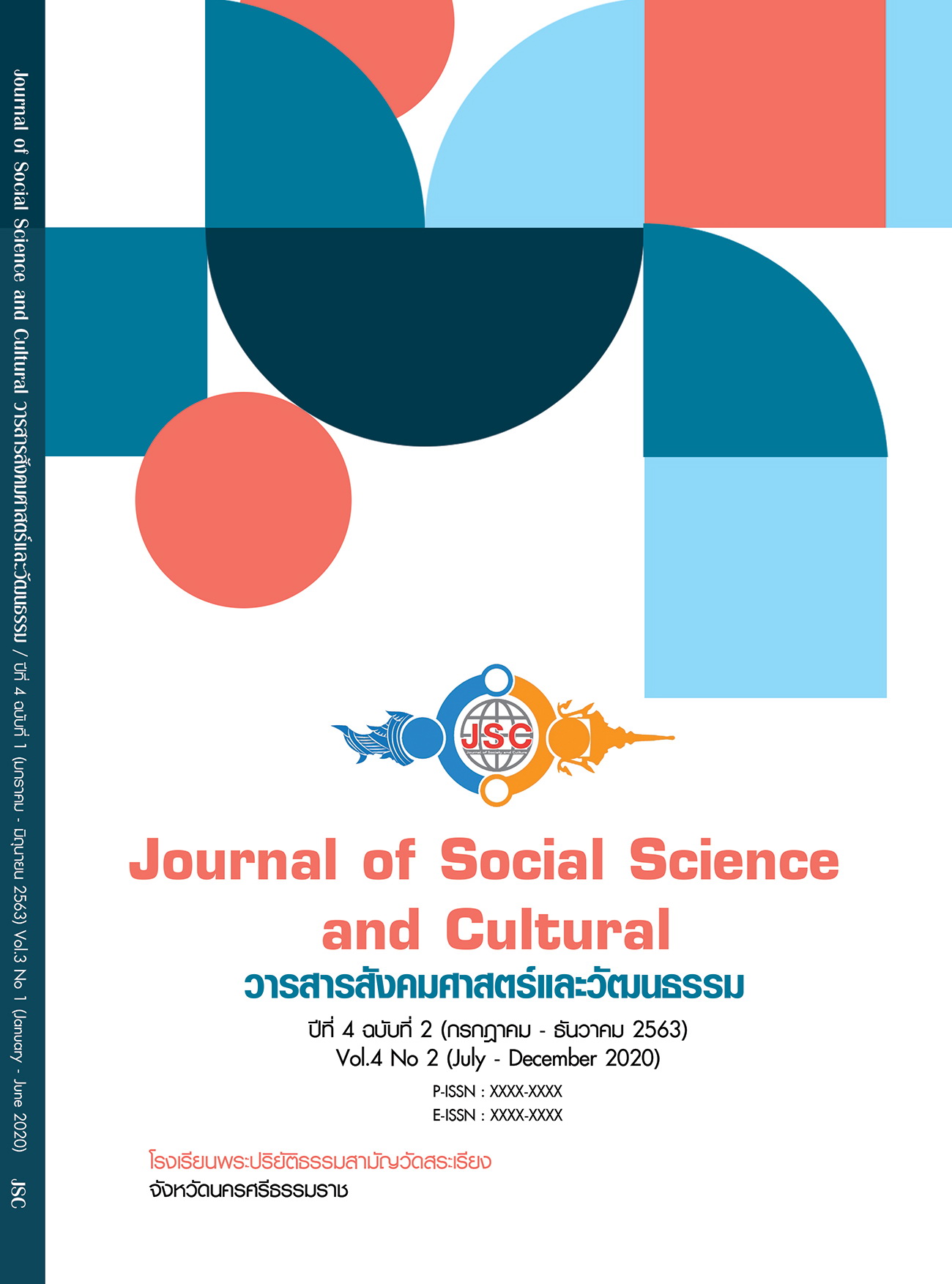“MANORA” ON THE BASE MANAGEMENT OF COLLECTIVE CULTURE: NORA TEIM MUANG TRANG
Main Article Content
Abstract
This article was presentation about history of “The Art of Nora” and “Southern Nora” showed valuable folk wisdom that primary to innovation or new actions that are created in the context of the area. The community and period of time were changed and refined parallel dynamics. The society was changed so affected to culture profound and wisdom of “Nora Teim” was local philosopher and local artist pass on knowledge by local culture animation have longevity. Changing Nora model development to international by using novel and modern musical for the show. The unique and influences the way of life that has absorbed into the blood. It is like the spiritual life of the southern people since ancient times that "came from Trang, nor the movie nor Nora" was compared to the local people as having the talent of the local performing arts. Nora is a special science of knowledge. As a guide to the life. It is an inherent feature of native people. Which people in the southern general may not sing and play, but there will be knowledge embedded in oneself that is accessible to the heart that will never forget. Because Nang Talung and Manohra gave both " Intelligence and emotion" It is a local cultural entertainment that provides entertainment, Is a medium that gives the essence in the heart, It is also the dynamic that drives the creation of faith to be unique to the people of the South. Therefore, the management of shared culture. It is a process of inheriting cultural knowledge, both science and art, linked to coexistence in society. "Multicultural" that fosters and recognizes values, protects, maintains, develops and creates sustainable popularity.
Article Details
References
ชวน เพชรแก้ว. (2559). โนรา: การอนุรักษ์และพัฒนา. สารอาศรมวัฒนธรรมวลัยลักษณ์, 16(1), 1-27.
ชุรีพร จ่าสอน. (2563). โบราณนานมา. เรียกใช้เมื่อ 2563 กุมภาพันธ์ 9 จาก https://www.facebook.com/ boraannaanma/ posts/2023387637915386/
พิทยา บุษรารัตน์. (2553). นาฏกรรมแห่งลุ่มทะเลสาบสงขลาการเปลี่ยนแปลงและความสัมพันธ์กับ สังคมและวัฒนธรรมของหนังตะลุงและโนรา. กรุงเทพมหานคร: สำนักงานกองทุนสนับ สนุนการวิจัย (สกว.).
พิทยา บุษรารัตน์ และเบ็ญจวรรณ บัวขวัญ. (2559). โนรา: การเปลี่ยนแปลงการปรับตัวและพลังสร้างสรรค์ในการดำรงอยู่ของคีตนาฏยลักษณ์แห่งภาคใต้. สารอาศรมวัฒนธรรมวลัยลักษณ์, 16(2), 41-64
วราภรณ์ นุ่นแก้ว. (2549). “โนราเติม เมืองตรัง”. กรุงเทพมหานคร: อมรินทร์พริ้นติ้งแอนด์พับลิชชิ่ง.
ศิลปะไทย. (2563). ศิลปะไทย. เรียกใช้เมื่อ 9 กุมภาพันธ์ 2563 จาก https:// sites.google.com/site/thaiartthailand/.
สมเจตนา มุนีโมไนย. (2544). มาแต่ตรังไม่หนังก็โนรา. กรุงเทพมหานคร: สำนักพิมพ์ศิลปะวรรณกรรม.
สำนักงานวัฒนธรรมจังหวัดพัทลุง. (2563). ศิลปะการแห่งโนราห์. เรียกใช้เมื่อ 9 กุมภาพันธ์ 2563 จาก https://www.m-culture.go.th/phatthalung/ewt_news.php?nid =508&filename=index.
สุธิวงศ์ พงศ์ไพบูลย์. (2549). สิ่งสำแดงถึงความเป็นท้องถิ่นของวรรณกรรม: กรณีวรรณกรรมท้องถิ่นภาคใต้. วารสารมนุษยศาสตร์สังคมศาสตร์ มหาวิทยาลัยทักษิณ, 1(1), 1-25.
สุนทรียา ไชยปัญหา และอุรารักษ์ ศรีประเสริฐ. (2559). แนวคิด ทฤษฏีวัฒนธรรมการจัดการ: การปรับตัวภายใต้ความแตกต่างทางวัฒนธรรม. วารสารวิชาการคณะวิทยาการจัดการ มหาวิทยาลัยราชภัฏมหาสารคาม, 1(2), 104-116.


